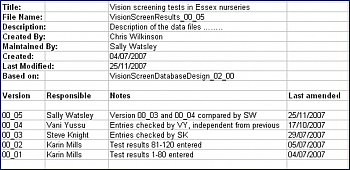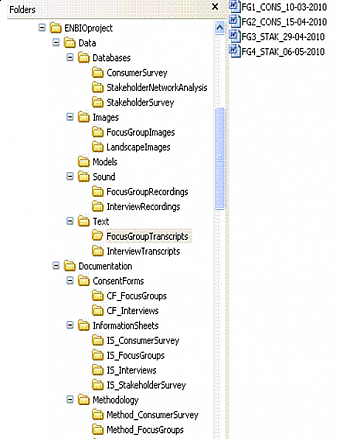Naming and organising files
A logical and consistent file naming system allows you and others to locate and use your data. You should be thinking about how to name and structure your data at the start of your project.
What do I need to consider when creating a file name?
- Decide on a file naming convention at the start of your project.
- Be brief but meaningful – file names should be easy to read but equally you need to be able to understand them.
- Avoid very long file names – will you be able to see them?
- Avoid using spaces and specialist characters – these might be processed differently by various software, causing difficulties in the future. It is often recommended that you use underscores rather than fullstops or spaces for these reasons.
- File names should outlast the data file creator who originally named the file eg "Corinne’s list" – when Corinne leaves, any new member of staff is going to be baffled.
- The filename should include as much descriptive information that will assist identification independent of where it is stored.
- Agree on a logical use of dates so that they display chronologically i.e. YYYY-MM-DD.
- Confirm which element of your naming system will be written first, so that files on the same theme are listed together and can therefore be found easily.
- Specify the amount of digits that will be used in numbering so that files are listed numerically e.g. 01, 002, etc.
How do I name my files so that I know which document is the most recent version?
Will you be using only one laptop or working in many locations? Are you the only person working on these files or might others make changes? Will you be storing all the different versions or will the files need to be synchronised?
In which case, it is good practice to record file status/versions using a 'revision' numbering system. Major changes to a file can be indicated by whole numbers, for example, v01 followed by v02 and so on. Minor changes can be indicated by increasing the decimal figure, for example, v01_01 indicates a minor change has been made to the first version, and v03_01 a minor change has been made to the third version.
Also, include a 'version control table' for each important document, noting changes and their dates alongside the appropriate version number of the document.

(image: UK Data Service - Training Resource: Formatting and Organising Research Data, April 2014 [PDF])
Lastly, agree who will complete any final files and mark them as 'final'.
How should I organise my files?
Use a logical folder structure and group files within folders so information on a particular topic is located in one place.

(image: UK Data Service - Training Resource: Formatting and Organising Research Data, April 2014 [PDF])
- Structure folders hierarchically so that you start with a limited number of folders with broader titles, and then create more specific folders within them.
- Name folders after the areas of work to which they relate and not after individuals. This avoids confusion if someone leaves the project.
- Follow existing folder naming procedures in your team or department if need be.
- Be consistent with your folder naming scheme.

